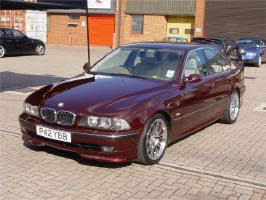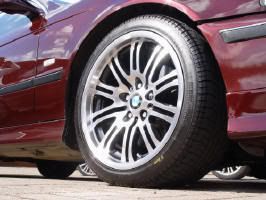
 |
|
Post Reply 
|
| Author | ||||||
ChrisMurray 
Newbie 

Joined: 05-December-2005 Location: W1 Status: Offline Points: 25 |
 Topic: Why its fine to fit spacers Topic: Why its fine to fit spacersPosted: 07-December-2005 at 08:02 |
|||||
|
There is a lot of bad sentiments towards wheel conversions, so I thought to present some information to you all. We buy all our spacers from here:
Edited by ChrisMurray |
||||||
 |
||||||
| Sponsored Links | ||||||
 |
||||||
M5player 
Groupie 
Joined: 21-November-2005 Location: Solihull Status: Offline Points: 64 |
 Posted: 07-December-2005 at 08:06 Posted: 07-December-2005 at 08:06 |
|||||
|
couldn't agree more!
|
||||||
 |
||||||
Nigel 
Moderator Group 

Joined: 09-November-2002 Status: Offline Points: 6941 |
 Posted: 07-December-2005 at 08:18 Posted: 07-December-2005 at 08:18 |
|||||
|
Very good advice, and thankyou, it may prevent people from having problems. If your car is not supplied with spacers from new, I'd still suggest...advise really...that you at least let your insurance people know. |
||||||
|
Best Wishes
Nigel |
||||||
 |
||||||
kickdownman 
Groupie 
Joined: 13-November-2005 Status: Offline Points: 93 |
 Posted: 07-December-2005 at 08:34 Posted: 07-December-2005 at 08:34 |
|||||
Chris, M. |
||||||
|
E39 540i (4.4i V8).... 0-60 - 6.2secs and 298 bhp....Canyon Red with Sand leather... 18" 'M' Double Spokes - 275's on the rear....
 
|
||||||
 |
||||||
b318isp 
Moderator Group 

Joined: 10-October-2002 Location: Ireland Status: Offline Points: 2057 |
 Posted: 07-December-2005 at 10:10 Posted: 07-December-2005 at 10:10 |
|||||
|
I have a few issues that you might clarify:
1. TUV certification relates to the spacer itself, not how it is used. 2. When spacers are fitted, it increases the leverage of the suspension, reducing the effective spring rate and potentially increases strain on suspension components. 3. On front wheels, spacers shift the contact patch centre away from the strut/kingpin axis. This may affect the steering reponses. 4. Who can determine the shear or bending stress effect on the wheel bolts? 5. It is unlikely any manufacturer would warrant the use of aftermarket spacers. A proper suspension designer can take into account the effect of spacers, no doubt this is why ACS, Porsche, etc., do so. However for the public, it isn't that simple. |
||||||
 |
||||||
ChrisMurray 
Newbie 

Joined: 05-December-2005 Location: W1 Status: Offline Points: 25 |
 Posted: 07-December-2005 at 12:12 Posted: 07-December-2005 at 12:12 |
|||||
|
My previous post simplified a few points that i will expand on. Great avatar by the way! Because the German motor industry regulates more stringently than the UK, most technical documents are never translated to English. 1. There are many types of TUV certification, some vehicle specific (like those in the H&R links - please look! http://www.h-r.com/bin/04EUTG110.pdf) These are usually entitled 'teilegutachten'. The component under test may have various restrictions and conditions for fitment (hinweise und auflagen), usually listed at the end of the document. 2. Fitting spacers is the same as fitting a wheel of lower offset. Each car has a range of acceptable offsets. Compare the different wheels specs fitted to a certain model to see that this range is quite broad, and clearly all within the range of acceptable values for a given model. Very rarely will car tuners fit wheels outside the oem range of offsets, simply because as the wheel width limit is approached, the wheel will have equally small clearances on inside and outside. 3. I hope you'll see the answer to this in (2) 4. Bolts do not primarily carry shear loads. They provide clamping force. The hub spigott carries the forces. Bolts are tested by various bodies and have documentation about their strengths for other component manufacturers to use 5. 'Aftermarket' spacer manufacturers supply oem to manufacturers. eg. Techart supply Porsche dealers. Brabus is classed as a manufacturer (by Kraftfahrtbundesamt) and their wheels, manufactured often by Ronal, require spacers for fitment to each different Mercedes model. The public has a choice. They can research their purchases and buy equipment that will work and is of high quality, or they can buy what is sold to them in a country where low quality products are the norm. I fully expect you to reply, but do please actually read what I have written, and visit the links so I don't have to repeat the same points Edited by ChrisMurray |
||||||
 |
||||||
sleeper 
Really Senior Member II 
Original and STILL best Joined: 26-March-2004 Location: East Sussex/Kent border Status: Offline Points: 2098 |
 Posted: 07-December-2005 at 12:22 Posted: 07-December-2005 at 12:22 |
|||||
|
I am looking at this with my Bro' who is fitting 328is wheels to his VR6. Although the offset and PCD are wayyyy different, he will only be using spacers to align the BMW wheel centre axis with where the VW axis was in the first place. Nothing wrong there and the geometry should be minimally affected (by increased width & diameter - same as buying new, bigger rims). FYI I asked my insurance company previously and they are fine with the use of spacers/adaptors within my policy, as long as the manufacturers tolerances are not exceeded. Also, the guy I spoke to said that TUV approval would be very 'useful' in the event of the worst happening as proof that they are a tested and certified part. This was Zurich BTW. |
||||||

|
||||||
 |
||||||
Nigel 
Moderator Group 

Joined: 09-November-2002 Status: Offline Points: 6941 |
 Posted: 07-December-2005 at 12:36 Posted: 07-December-2005 at 12:36 |
|||||
|
Regarding insurance, I've had so many different responses, from different companies, I think its only fair to advise that people at least consult them.
|
||||||
|
Best Wishes
Nigel |
||||||
 |
||||||
ChrisMurray 
Newbie 

Joined: 05-December-2005 Location: W1 Status: Offline Points: 25 |
 Posted: 07-December-2005 at 12:42 Posted: 07-December-2005 at 12:42 |
|||||
|
yes, PCD adjusting spacers are available. As for the geometry changes, they will still be within acceptable ranges, as the documentation will show. We haven't discussed hubcentricity yet... |
||||||
 |
||||||
b318isp 
Moderator Group 

Joined: 10-October-2002 Location: Ireland Status: Offline Points: 2057 |
 Posted: 08-December-2005 at 06:37 Posted: 08-December-2005 at 06:37 |
|||||
|
Thanks for your thought provoking reply. Can I challange a bit further?
I think this supports my original comment.
Who defines the range of acceptable offsets and how is a member of the public to know? Your comment on car tuners may be valid, but to generalise would not be wise. Some people fit spacers with no idea of consequence - especially when completely the wrong wheel is being adapted to fit a car. How often have you heard of arches being rolled to make a wheel fit?
Good point about the clamping funciton, but older cars (e.g. those with studs) may not have hubs spiggots so may be in shear. If the wheels are purchased with the incorrect sized centre hole for the hub or a spacer has no spigot, then they will also be in shear - and much more seriously, may significantly compromise the loads on them as envisaged by the designers. They also must take tensile loads when cornering. If a stock bolt or stud is used, then there will be less thread available to take this load. Finally, the longer the bolt or stud, the more prone to bending moments, although this effect is probably minor.
I have no reason to doubt these reputable companies who have the engineering competency to incorporate them into their designs.
I completely disagree as you are now generalising by assuming people can and will do this. In the main, there is variance in the quality and design of spacers. However, the major issue here is that there are few people who have an understanding of the consequences of fitting any particular spacer. Be very clear on what I am saying, I have no doubt that spacers can be used safely if all the engineering aspects are considered and incorporated into the suspension design. However, it not correct to generalise and say that spacers are safe to use for the general public as it is impossible to generalise on the vehicles, wheels, spacers nor competencies involved. |
||||||
 |
||||||
ChrisMurray 
Newbie 

Joined: 05-December-2005 Location: W1 Status: Offline Points: 25 |
 Posted: 08-December-2005 at 15:58 Posted: 08-December-2005 at 15:58 |
|||||
Does a coke can unrolled and pierced with a corkscrew count as a spacer? Whn I say spacer, I mean a properly designed component, tested and approved with documentation to govern its use. This is the only type of spacer I sell, but I am the only wheel dealer in the UK who refuses to sell non-genuine wheels. I suspect your definition of spacer is wider. When cut and shut second hand cars came to market, was everyone advised to stop buying used cars? No, legislation protected the uninformed public from making bad decisions so that poor quality unsafe products could not be sold so easily. |
||||||
 |
||||||
b318isp 
Moderator Group 

Joined: 10-October-2002 Location: Ireland Status: Offline Points: 2057 |
 Posted: 12-December-2005 at 08:55 Posted: 12-December-2005 at 08:55 |
|||||
My arguement is not with you as you seem to know your subject well. The role of the authrorities mentioned sort of falls to us Moderators on the board! |
||||||
 |
||||||
Post Reply 
|
|
|
|
| Forum Jump | Forum Permissions  You cannot post new topics in this forum You cannot reply to topics in this forum You cannot delete your posts in this forum You cannot edit your posts in this forum You cannot create polls in this forum You cannot vote in polls in this forum |